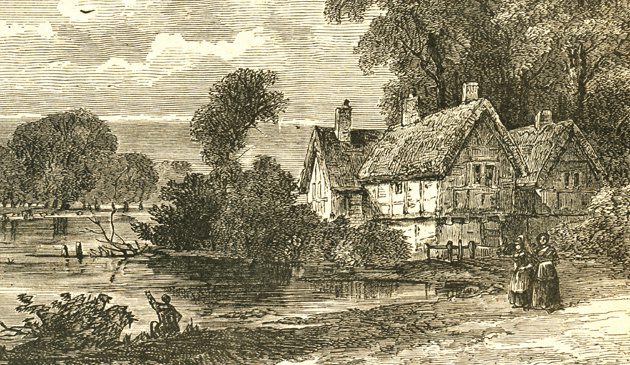London’s Restoration pleasure gardens

The water entrance to Cuper’s Gardens with its octagonal gazebo, across the Thames from the Savoy and Somerset House. From the entrance, known as Cuper’s Stairs, a short lane led to the pleasure gardens. The print dates from about 1730 and is taken from a painting by the maritime artist Samuel Scott.
Another pleasure garden was Mother Huff’s Tea Garden, off the Spaniard’s Road at Hampstead, which, despite the name, was also licensed to sell alcohol. It opened in 1678 and flourished for the following 50 years, although by 1728 Mother Huff herself had moved to a nearby inn. The site of the tea garden was later used to build Elms House, which is now a Grade II listed building.
A different type of entertainment venue was a ‘musical summer-house’ that floated on the Thames, downstream of Waterloo Bridge close to where the National Theatre is now located. It was unconnected to the riverbank and thus reached only by boat. An early 18th century illustration shows it as a rectangular structure built onto a floating platform, with five turrets, one in each corner and another at its centre. It was briefly mentioned by Pepys in April 1668, when he called it ‘the Folly’. A visitor in 1700 described it as a “whimsical piece of architecture” with a dubious reputation for “amorous intrigues”. In later years it became a gambling den.
The Folly was moored very close to where the Howard family, Earls of Arundel, owned some land, previously part of Lambeth Marsh, on the opposite riverbank to their Arundel House. They leased the land to their gardener Abraham Boydell Cuper and it was either him or his son who used it to create Cuper’s Gardens, perhaps inspired by the New Spring Gardens. The public could stroll along the pathways that wound through the trees, listen to music, and take refreshment. It included a bowling green and rectangular pond. The gardens were known as a place for amorous encounters and gained the nickname ‘Cupid’s Gardens’.
In the earlier part of the century Thomas Howard, Earl of Arundel had created a collection of antiquities during his foreign travels. He went into exile to Italy during the Civil War, eventually dying there, and the collection was partly destroyed. John Evelyn witnessed it at Arundel House in 1667 and lamented the “precious monuments miserably neglected and scatter’d up and down the garden”. Arundel House was demolished in 1678 by Henry Howard, Earl of Arundel and Duke of Norfolk, and some of the remains of the antiquities went to Oxford University. The Cupers managed to salvage others and used them to line the central walkway of their gardens. The contemporary write John Aubrey commented that “the conveniency of its arbours, walks and several remains of Greek and Roman antiquities, have made this place much frequented”.
In 1686 Bodwyn Cuper was granted a lease by the Archbishop of Canterbury on a seven-acre plot of adjoining land and the gardens were extended. Cuper’s Gardens and the adjacent tavern were acquired in 1738 by Ephraim Evans who did much to improve them, creating an orchestra pavilion and installing an organ. He died just two years later and under the management of his widow the resort became famous for its firework displays accompanied by music by composers such as Handel.
In later years Cuper’s Gardens became notorious for the pickpockets that operated there and for that reason the resort lost its licence in 1753. It continued to operate for several years as an unlicensed tea garden but finally closed in 1760. Part of the site became Beaufoy’s vinegar works, which in turn made way for the southern approach to Waterloo Bridge in the early 19th century. The remainder was used as timber wharves, and from the 20th century occupied by the National Theatre.
Sources include: David Coke & Alan Borg ‘Vauxhall Gardens – A History’; The Diary of Samuel Pepys; Felix Barker & Peter Jackson ‘Pleasures of London’; Edward Walford ‘Old & New London’; Edgar Sheppard ‘The Old Royal Palace of Whitehall’ (1902); John Richardson ‘The Annals of London’; Jenny Uglow ‘Hogarth – A Life and a World’; https://vauxhallhistory.org/cupers-gardens/. With thanks to Hannah Renier (author of ‘Lambeth Past’) for her useful comments.
< Back to Restoration London


